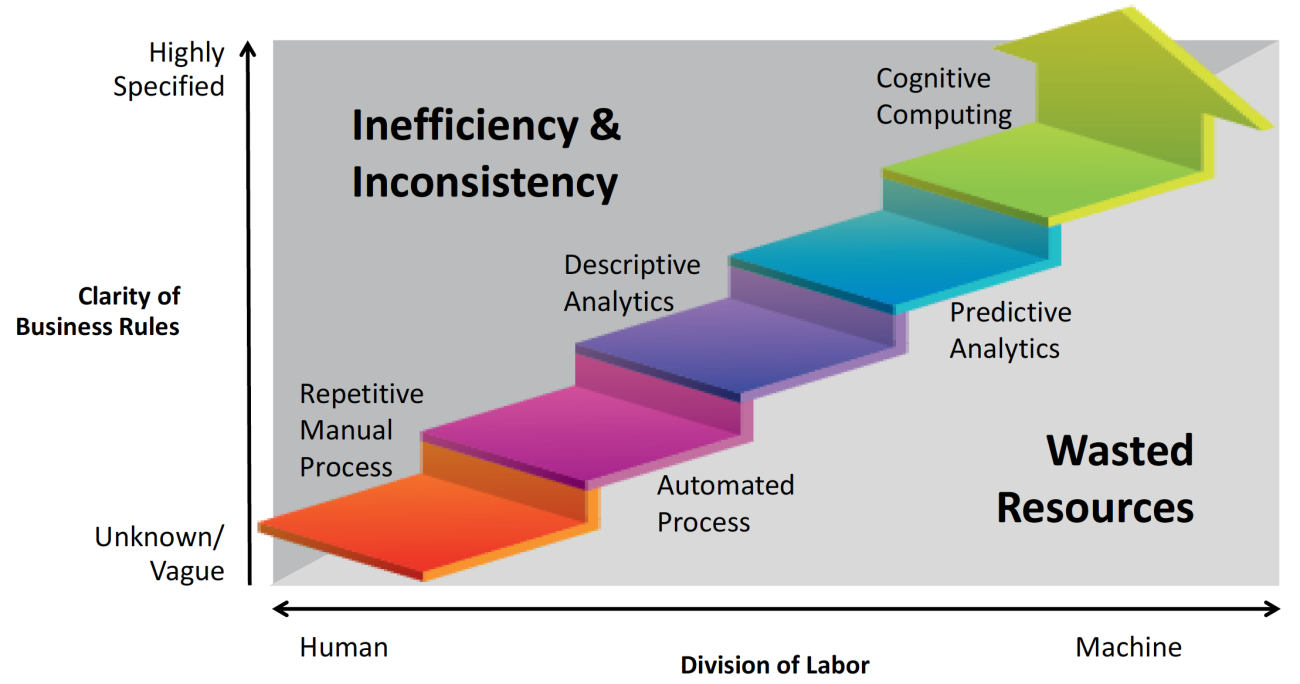In addition, some decisions depend heavily on creative instincts that counter established patterns. Strategic decisions on what fashions a retailer should stock or what new features a company should add to a digital product are probably not well suited to cognitive computing. Similarly, the unique customer interactions typical in one-to-one relationship banking have proven hard to characterize for cognitive computing purposes. Several companies in our research had abandoned initiatives because the business decisions they were attempting to model proved to be fairly unique rather than repetitive.
Lesson 3: Machines Learn Only if Humans Do a Great Deal of Teaching
Computers won games like Jeopardy! and Go because scientists spent several years parsing the problem, engineering a complex set of algorithms to fit the problem, and finding and structuring massive amounts of data so that the computer could tweak the algorithms, then doing all that over and over again. Preparing Watson to win at Jeopardy!, for example, was a six-year endeavor.[foot]Wikipedia, The Free Encyclopedia, s.v. “Watson (computer),” https://en.wikipedia.org /wiki/Watson_(computer).[/foot]
After a two-year effort, Google has rolled out a successful application of an energy management system that has reduced energy usage for cooling its data centers by 40%.[foot]Rich Evans and Jim Gao, “DeepMind AI reduces energy used for cooling Google data centers by 40%,” the Keyword (Google blog), July 20, 2016, https://blog.google /topics/environment/deepmind-ai-reduces-energy-used-for/.[/foot] To optimize energy efficiency, Google fed the system data on the equipment and design of the facility, as well as historical data collected by thousands of sensors—data such as external temperatures, pump speeds, and temperature settings—and used it to analyze outcomes and train an ensemble of deep neural networks. The resulting system considers both existing conditions and predictions of data center temperature and pressure over the next hour in determining energy settings.
Many companies have been surprised by the time required to feed data to and teach their computers. For example, using cognitive computing in healthcare diagnosis requires extensive ingestion of medical research as well as historical data on patient conditions and outcomes. Some applications require a great deal of teaching before algorithms stabilize: natural language processing follows rules of grammar, but vocabulary can be highly variable. In contexts where rapid change occurs, that teaching role will continue to require significant commitment, because recommendation engines have to be retrained—sometimes quite often—to adapt to changes in products and services.
Lesson 4: In Many Cases, Vendors Are Best Positioned to Recoup Investments in Cognitive Computing
In Google’s case, the time and money invested in its data center energy management system will pay off, because of how much electricity the company consumes: .01% of the world’s supply. That kind of payback has often eluded other companies that have tackled big projects.
Given that the power of cognitive computing stems from the ability to rapidly process massive amounts of data, the payback comes only after a system has a solid knowledge base. For many business applications, a single company will not be able to justify the investment required to collect, architect, and store the data—while also engineering the early models that provide the starting point for machine learning. Vendors, on the other hand, can recoup their investments by selling systems to multiple companies. For many business cognitive computing applications, companies will do well to wait for vendor products that offer both a knowledge base and an early model.
For example, ROSS Intelligence has developed a cognitive computing application that searches case law to help lawyers identify key legal precedents. ROSS continuously updates its knowledge base of cases to deliver increasingly useful searches. It can justify the investment because multiple law firms depend on its product; few law firms could afford to develop a competitive system. But for many business applications, competitive advantage will come from using tools better—much like the case with ERPs—and not from having a superior, home-grown tool.
Lesson 5: Companies Should Proceed Incrementally to Implement Cognitive Computing Applications
Successful business applications of cognitive computing develop incrementally, as individuals grow in their understanding of business rules. Vague business rules—which are common—limit the opportunities to effectively deploy cognitive computing. If the desired outcome is not clear or the required data is not available, a task is poorly suited to cognitive computing.
Businesses establish good business rules by having the people who execute a task learn the relationships between various inputs and outcomes. Over time, they understand outcomes well enough that repetitive tasks can be automated. Automation allows individuals to test business rules in different contexts, analyze the relationships between inputs and outcomes, and then elaborate or tweak the rules. In closed systems, the relationships between inputs and outcomes may become clear enough to enable predictive analytics. For complex problems, cognitive computing becomes an option if the system can access enough useful data such that the machine has a basis for adapting its own algorithms. Figure 1 describes this gradual, value-adding approach to cognitive computing.
A brief example helps to explain how this works. In call centers, companies are looking to apply cognitive computing to improve accuracy, consistency, and speed of customer service. To do so, they first must establish clear business rules on how to distinguish a simple repetitive need (like password reset) from a problem that requires more examination and personal attention (like individualized advice on a product). This allows the company to eventually automate call triage, directing simple calls to voice response systems, and handing only those calls that need personal attention to call center agents. If accountable people in the company track and analyze the outcomes of automated call triage, they will identify issues (such as when customers became frustrated) and improve their business rules accordingly. This will allow the company to strengthen the triage process and perhaps to automate more solutions. Eventually, the company could incorporate data about customers into existing models and make predictions about how a call should be handled. At that point, a sophisticated natural language processing tool can be trained to recognize the nuances of language, customer emotion, and business situations, thus further enhancing the process. This will take time, of course, but it can incrementally increase efficiency and customer satisfaction.
Our findings suggest that, contrary to conventional wisdom, cognitive computing is not likely to be disruptive for most companies. Some companies will be able to profit from cognitive computing by developing consumer or business products that embed cognitive computing capabilities. But most business leaders will find that the best way to leverage the opportunities and manage the risks of cognitive computing is to invest in incremental business process improvements. Over time, these business process improvements will lead to changes in job requirements. In many cases, companies will generate greater lift from increased process automation than from subsequent cognitive computing.
The speed at which companies can generate benefits from machine learning will depend on how quickly their people can clarify business rules and desired outcomes and the data that may influence those outcomes. Thus, to generate benefits from cognitive computing, we advise companies to invest in making their people smarter in anticipation of the benefits from smarter machines.




